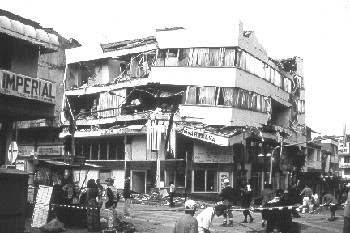
The Colombian Earthquake of January 1999: Lessons for Seismic Disaster
Prevention and Response
Omar D. Cardona A.
On 25 January 1999, at 1:19 p.m. local time, a 6.2ML earthquake shook the Colombian Midwest, a traditional coffee-growing
area. Severe damages were reported in Armenia (270,000 inhabitants), the capital of
Quindio Department, as well as in the capital of Risaralda Department, Pereira (380,000
inhabitants). The death toll rose to 1,230. Hospitals tended to 5,300 patients with
various types of injuries, and it is estimated that 200,000 people lost their home or
workplace. With close to 50,000 buildings damaged or destroyed, the impact of the quake
may well have reached 1.5 percent of Colombia’s GNP.
 Most of the damage involved older buildings that had not been
reinforced and had been built before the passing, in 1984, of the first building code to
take into account seismic hazards as a result of the 1983 PopayŠn earthquake. Most of the damage involved older buildings that had not been
reinforced and had been built before the passing, in 1984, of the first building code to
take into account seismic hazards as a result of the 1983 PopayŠn earthquake.
The Armenia tremors also caused a significant number
of landslides affecting the roads that connect that city with the rest of the country.
From the moment the first rumblings of the disaster
were detected by the National Seismological Network, the National Disaster Prevention and
Response System went into action. This decentralized inter-institutional system was
established after the Armero del Ruiz volcanic eruption of 1985. Its value became clear
after the magnitude of the quake overwhelmed both the Local and the Regional Disaster
Prevention and Response Committees.
Lessons
learned
The Armenia disaster taught many lessons about
seismic engineering and disaster prevention.
A city with an abundant inventory of fragile
non-reinforced masonry structures, and reinforced concrete buildings which do not meet the
minimum criteria of seismic resistance, is a city at risk.
The adverse interaction of non-structural elements
with existing structures caused severe damage, and may have led to the collapse of
buildings. The short-column effect was common, as was the torsion caused by the
asymmetrical configuration of masonry walls and the poor structural behaviour of buldings
with irregular shapes.
Once again, it became clear that it pays to comply
with earthquake-resistant building codes. This approach protects both lives and property.
The need to retrofit buildings that host valuable
community services was highlighted by the quake. Hospitals, firefighters’ facilities,
and all other facilities aimed primarily at providing public services, must be examined by
knowledgeable engineers and retrofitted, as needed, to withstand seismic events.
Traditional knowledge must not be
disregarded. Starting in the 19th Century, local traditions in bamboo construction have withstood the
test of time. They are a technology that has evolved and perfected itself because of its
ability to withstand earthquakes.
Local response is crucial. Municipalities and
other local governments must have a Disaster Prevention and Response Committee with enough
resources and adequate leadership to handle any emergency in progress and prepare for
potential threats.
At the level of medium-sized to large human
settlements, there is a need for inter-institutional risk mitigation programmes that
comprise technical know-how, planning, education, public information, and preparedeness.
Speaking of this particular instance, the National
Disaster Prevention and Response Directorate must be strengthened. The technical capacity
and convening power it had in the past must be re-invigorated by providing the necessary
resources.
To contact the author of the previous report,
please write to Omar D. Cardona, Director, Centro de Estudios sobre Desastres y Riesgos
(CEDERI), Universidad de los Andes, Bogota, Colombia, at: ocardona@uniandes.edu.co |



